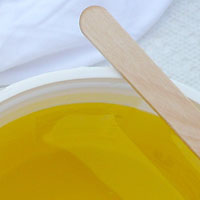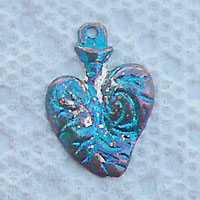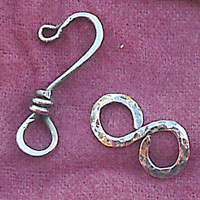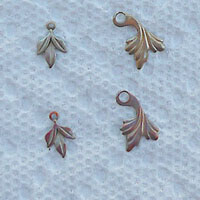Past Blog Posts:
Experimenting with Liver of Sulphur
Filed under Art Projects, Design Team, Jewelry, Tutorials
 by Teri Calia
by Teri Calia
Supply List
- Liver of Sulfur Gel (NOTE: this Gel is easier to work with than the dry version in this tutorial!)
- Brass Leaves
Liver of Sulfur (sometimes Sulphur) is Sulfurated Potash. It is used primarily in metalworking to form a patina, turning silver, bronze and copper brown or black. It will work on any uncoated metal that contains some silver, bronze or copper in its mix.
For this tutorial I decided to experiment with some of the charms and metal bits available through Alpha Stamps. Most of the bits I used were brass so I didn’t get dramatic results, but I did get some nice patinas I didn’t expect! I especially love the patinas achieved on the milagros which are generally made of junk or scrap metal.
Instructions:

 The first step in using Liver of Sulfur is to gather your supplies and set up your work area. Keep in mind Liver of Sulfur is very stinky and corrosive. I worked outside in a well ventilated area and covered my Liver of Sulfur when it wasn’t in use. Liver of sulphur doesn’t stain your fingers if you wash it off with soap, but it will stain clothing, your favorite work table, the wall, your cat’s fur and the toy your 3 year old managed to dip while your back was turned. Please be careful!
The first step in using Liver of Sulfur is to gather your supplies and set up your work area. Keep in mind Liver of Sulfur is very stinky and corrosive. I worked outside in a well ventilated area and covered my Liver of Sulfur when it wasn’t in use. Liver of sulphur doesn’t stain your fingers if you wash it off with soap, but it will stain clothing, your favorite work table, the wall, your cat’s fur and the toy your 3 year old managed to dip while your back was turned. Please be careful!
 To mix your Liver of Sulfur solution, fill a disposable plastic or glass bowl with warm water. Do not reuse the bowl for anything else! Add a chunk of the Liver of Sulfur and let it dissolve. You can use a craft stick or plastic utensil to stir the mixture, making sure there are no undissolved pieces remaining. When your mixture is ready you will want to start right away (or cover it tightly and save it until you are ready). Simply drop your metal bits in and watch what happens.
To mix your Liver of Sulfur solution, fill a disposable plastic or glass bowl with warm water. Do not reuse the bowl for anything else! Add a chunk of the Liver of Sulfur and let it dissolve. You can use a craft stick or plastic utensil to stir the mixture, making sure there are no undissolved pieces remaining. When your mixture is ready you will want to start right away (or cover it tightly and save it until you are ready). Simply drop your metal bits in and watch what happens.
 Anything made of uncoated copper will turn dark immediately, you will want to remove it quickly and re-dip it if you want to have a darker patina. You can see in the photos just how dark the patina is on my copper hook and eye clasp. (The clasp was made by me out of 16 gauge copper wire I bought at the hardware store. It’s quite cheap and easy to work with. Remember craft wire is coated to maintain it’s shine and will not work with Liver of Sulfur.)
Anything made of uncoated copper will turn dark immediately, you will want to remove it quickly and re-dip it if you want to have a darker patina. You can see in the photos just how dark the patina is on my copper hook and eye clasp. (The clasp was made by me out of 16 gauge copper wire I bought at the hardware store. It’s quite cheap and easy to work with. Remember craft wire is coated to maintain it’s shine and will not work with Liver of Sulfur.)
 The brass bits I dunked had to sit in the solution for about 5 minutes to show any difference. They did have a coating on them, but I sanded some of them and left the others as they were so you could see the difference. In the “after” photo of bits and charms, all of the bits and charms on the top of each group is coated and the ones on the bottom have been sanded. You can see how much better the Liver of Sulfur works when the brass has been sanded. I have heard that you can also remove the coating from your metal bits by soaking them in bleach overnight. I haven’t tried this yet but it is definitely worth exploring further.
The brass bits I dunked had to sit in the solution for about 5 minutes to show any difference. They did have a coating on them, but I sanded some of them and left the others as they were so you could see the difference. In the “after” photo of bits and charms, all of the bits and charms on the top of each group is coated and the ones on the bottom have been sanded. You can see how much better the Liver of Sulfur works when the brass has been sanded. I have heard that you can also remove the coating from your metal bits by soaking them in bleach overnight. I haven’t tried this yet but it is definitely worth exploring further.
 The Milagros I dunked had to sit in the Liver of Sulfur for about 10 minutes, but I love the way they turned out. There is no need to sand these babies to get results. They turn some interesting colors and I would suggest leaving them in the solution for an even longer period of time to see what you might get.
The Milagros I dunked had to sit in the Liver of Sulfur for about 10 minutes, but I love the way they turned out. There is no need to sand these babies to get results. They turn some interesting colors and I would suggest leaving them in the solution for an even longer period of time to see what you might get.
Once you have achieved the depth of patina you want, take your metal bits out and soak them in clean cool water. You can also wash them in the sink with soap and water if you want to. The “bath” you give your bits will stop the corrosive action of the Liver of Sulfur, which causes a patina to develop. After their “bath” you will want to dry your metal bits on paper towels.
 Once they have dried you can use your newly patinaed treasures just as they are or if you want them a bit shinier you can rub them with a Jewelry Polishing Cloth. Jewelry Polishing Cloths are widely available, I think I bought my last one at Target (they are used to keep Sterling Silver jewelry polished, so check the fine jewelry department).
Once they have dried you can use your newly patinaed treasures just as they are or if you want them a bit shinier you can rub them with a Jewelry Polishing Cloth. Jewelry Polishing Cloths are widely available, I think I bought my last one at Target (they are used to keep Sterling Silver jewelry polished, so check the fine jewelry department).
After using Liver of Sulfur once you will want to use it again and again. It’s so much fun to see how different metals react and to make truely unique charms and bits for you art and jewelry projects.
A note on disposal:
According to the MSDS (Material Safety Data Sheet) information published on Liver of Sulfur it can be neutralized before disposal with Sodium Bicarbonate (aka Baking Soda) then flushed down a drain or toilet with lots of water.

